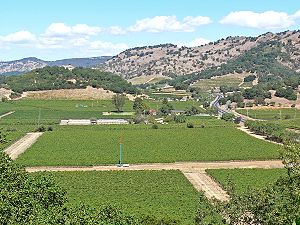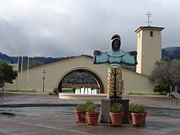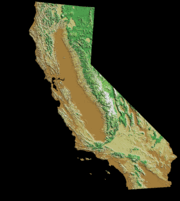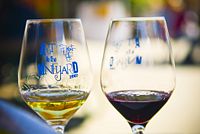California wine
| California (wine region) | |
 Vineyards in the Napa Valley AVA |
|
| Official name | State of California |
|---|---|
| Appellation type | U.S. state |
| Year established | 1850 |
| Years of wine industry | 1769-present |
| Country | United States |
| Sub-regions | List of California AVAs |
| Total area | 158,302 square miles (410,000 km2) |
| Size of planted vineyards | 480,000 acres (1,942 km2)[1] |
| Grapes produced | Albariño, Alicante Bouschet, Alvarelhão, Barbera, Bastardo, Black Muscat, Cabernet Franc, Cabernet Sauvignon, Carignan, Charbono, Chardonnay, Chenin Blanc, Cinsaut, Colombard, Concord, Dolcetto, Dornfelder, Flora, Freisa, Gamay Beaujolais, Gamay Noir, Gewürztraminer, Grenache, Malbec, Malvasia, Marsanne, Merlot, Mourvèdre, Muscat Canelli, Muscat of Alexandria, Nebbiolo, Niagara, Orange Muscat, Palomino, Petit Verdot, Petite Sirah, Pinot Blanc, Pinot Gris, Pinot Meunier, Pinot Noir, Primitivo, Riesling, Roussanne, Rubired, Ruby Cabernet, Sangiovese, Sauvignon Blanc, Sémillon, Souzão, Symphony, Syrah, Tempranillo, Teroldego, Tinta Amerela, Tinta Cao, Tinta Madeira, Touriga Nacional, Trebbiano, Trousseau gris, Valdiguié, Verdelho, Viognier, Zinfandel[1] |
| No. of wineries | Over 1,200[1] |
California wine is wine made in the U.S. state of California. Nearly three-quarters the size of France, California accounts for nearly 90 percent of entire American wine production. The production in California alone is one third larger than that of Australia. If California were a separate country, it would be the world's fourth-largest wine producer.[2]
The state's viticultural history dates back to the 18th century when Spanish missionaries planted the first vineyards to produce wine for Mass.
Following a wine renaissance in the mid-20th century, Californian wine entered the international stage at the 1976 Judgment of Paris wine competition when Californian wines beat out French wines in both red and white wine categories. Today there are more than 1,200 wineries in the state, ranging from small boutique wineries to large corporations like E & J Gallo Winery with distribution across the globe.[3]
Contents |
History

The state of California was first introduced to Vitis vinifera vines in the 18th century by the Spanish, who planted vineyards with each mission they established. The wine was used for religious sacraments as well as for daily life. The vine cuttings used came from Mexico and were the descendant of the "common black grape" (as it was known) brought to the New World by Hernán Cortés in 1520. The grape's association with the church caused it to become known as the Mission grape, which was to become the dominant grape variety in California until the 20th century.[3]
The California Gold Rush in the mid-19th century brought waves of new settlers to the region, increasing the population and local demand for wine. The newly growing wine industry took hold in Northern California around the counties of Sonoma County AVA and Napa. During this period some of California's oldest wineries were founded including Buena Vista Winery, Charles Krug Winery, Inglenook Winery and Schramsberg Vineyard. Chinese immigrants played a prominent role in the developing of the Californian wine industry during this period-building wineries, planting vineyards, digging the underground cellars and harvesting grapes. Some even assisted as winemakers prior to the passing of the Chinese Exclusion Act which severely affected the Chinese community in favor of encouraging "white labor." By 1890, most of the Chinese were out of the wine industry.[3]
Phylloxera and Prohibition
The late 19th century also saw the advent of the phylloxera epidemic which had already ravaged French and other European vineyards. Vineyards were destroyed and many smaller operations went out of business. Fortunately the remedy of grafting resistant American rootstock was well known and the Californian wine industry was able to quickly rebound and utilized the opportunity to expand the plantings of new grape varieties. By the turn of the 20th century nearly 300 grape varieties were being grown in the state, supplying its nearly 800 wineries. Worldwide recognition seemed imminent until January 16, 1919 when the 18th Amendment ushered in the beginning of Prohibition. Vineyards were ordered to be uprooted and cellars were destroyed. Some vineyards and wineries were able to survive by converting to table grape or grape juice production. A few more were able to stay in operation in order to continue to provide churches sacramental wine, an allowed exception to the Prohibition laws. But most went out of business. By the time that Prohibition was repealed in 1933, only 140 wineries were still in operation.[3]

It took time for the Californian wine industry to recover from this setback. By the 1960s, California was primarily known for its sweet port-style wines made from Carignan and Thompson Seedless grapes. However a new wave of winemakers soon emerged and helped usher in a renaissance period in California wine with a focus on new winemaking technologies and an emphasis on quality. Several well known wineries were founded in this decade including Robert Mondavi, Heitz Wine Cellars and David Bruce Winery. As the quality of Californian wine improved, the region started to receive more international attention. A watershed moment for the industry occurred in 1976 when British wine merchant Steven Spurrier invited several Californian wineries to participate in a blind tasting event in Paris. It was to compare the best of California with the best of Bordeaux and Burgundy. In an event known as the The Judgment of Paris, Californian wines shocked the world by sweeping the wine competition in both the red and white wine categories. Throughout the wine world, perspectives about the potential of California wines started to change. The state's wine industry continued to grow as California emerged to become one of the world's premier wine regions.[3]
Climate and geography
- See also: Geography of California

California is very geologically diverse region and is equally varied in the range of climates and terroirs that can be found. Most of the state's wine regions are found between the Pacific coast and the Central Valley. The Pacific Oceans and large bays, like San Francisco Bay serve as tempering influences to the wine regions nearby providing cool winds and fog that balance the heat and sunshine.[3] While drought can be a viticultural hazard, most areas of California receive sufficient amounts of rainfall with the annual rainfall of wine regions north of San Francisco between 24-45 inches (615-1150 mm) and the more southern regions receiving 13-20 inches. Winters are mild with little threat of frost damage though springtime frost can be a hazard. To curb the threat of frost, vineyard owners will often employ the use of wind machines, sprinklers and smudge pots to protect the vines.[4]
While California's wine regions can be generally classified as having a Mediterranean climate, there are also regions with more continental climates. Proximity to the Pacific or bays as well as unobstructed access to the cool currents that come off them will dictate the relative coolness of the wine region. Areas surrounded by mountain barriers, like some parts of Sonoma and Napa counties will be warmer due to the lack of this cooling influence. The soil types and landforms of California vary greatly, having been influenced by the plate tectonics of the North American and Pacific Plates. In some areas the soils can be so diverse that vineyards will establish blocks of the same vine variety planted on different soils for purpose of identifying different blending components. This diversity is one of the reasons why California has so many different and distinct American Viticultural Areas.[4]
Wine regions
- See also: List of California AVAs
California has over 427,000 acres (1,730 km2) planted under vines mostly located in a stretch of land covering over 700 miles (1,100 km) from Mendocino County to the southwestern tip of Riverside County. There are over 107 American Viticultural Areas (AVAs), including the well known Napa, Russian River Valley, Rutherford and Sonoma Valley AVAs. The Central Valley is California's largest wine region stretching for 300 miles (480 km) from the Sacramento Valley south to the San Joaquin Valley. This one region produces nearly 75% of all California wine grapes and includes many of California's bulk, box and jug wine producers like Gallo, Franzia and Bronco Wine Company.[3]
The wine regions of California are often divided into 4 main regions-[5]
- North Coast - Includes most of North Coast, California, north of San Francisco Bay. The large North Coast AVA covers most of the region. Notable wine regions include Napa Valley and Sonoma County and the smaller sub AVAs within them. Mendocino and Lake County are also part of this region.
- Central Coast - Includes most of the Central Coast of California and the area south and west of San Francisco Bay down to Santa Barbara County. The large Central Coast AVA covers the region. Notable wine regions in this area include Santa Clara Valley AVA, Santa Cruz Mountains AVA, San Lucas AVA, Paso Robles AVA, Santa Maria Valley AVA and Santa Ynez Valley.
- South Coast - Includes portion of Southern California, namely the coastal regions south of Los Angeles down to the border with Mexico. Notable wine regions in this area include Temecula Valley AVA, Antelope Valley/Leona Valley AVA, San Pasqual Valley AVA and Ramona Valley AVA.
- Central Valley - Includes California's Central Valley and the Sierra Foothills AVA. Notable wine regions in this area include the Lodi AVA.
Grapes and wines

Over a hundred grape varieties are grown in California including French, Italian and Spanish wine varietals as well as hybrid grapes and new vitis vinifera varieties developed at the UC Davis Department of Viticulture and Enology. The seven leading grape varieties are:[3]
Other important red wine grapes include Barbera, Cabernet franc, Carignane, Grenache, Malbec, Mouvedre, Petite Sirah, Petit Verdot and Sangiovese. Important white wine varietals include Chenin blanc, French Colombard, Gewürztraminer, Marsanne, Muscat Canelli, Pinot blanc, Pinot gris, Riesling, Roussane, Sémillon, Trousseau gris, and Viognier.[6]
Up until the late 1980s, the Californian wine industry was dominated by the Bordeaux varietals and Chardonnay. Sales began to drop as wine drinkers grew bored with the familiarity of these wines. Groups of winemakers like Rhône Rangers and a new wine wave of Italian winemakers dubbed "Cal-Ital" reinvigorated the industry with new wine styles made from different varietals like Syrah, Viognier, Sangiovese and Pinot grigio. The Santa Cruz based Bonny Doon Vineyard was one of first wineries to actively promote these more obscure grape varieties. The large variety of wine grape also encourages a large variety of wines. California produces wines made in nearly every single known wine style including sparkling, dessert and fortified wines.[3]
New World wine styles

While Californian winemakers increasingly craft wines in more "Old World" or European wine styles, most Californian wines (along with Australia, New Zealand, Chile and Argentina) favor simpler, more fruit dominant New World wines. The reliably warm weather allows many wineries to use very ripe fruit which brings up a more fruit forward rather than earthy or mineralic style of wine. It also creates the opportunity for higher alcohol levels with many Californian wines having over 13.5%. The style of Californian Chardonnay differs greatly from wines like Chablis with Californian winemakers frequently using malolactic fermentation and oak aging to make buttery, full bodied wines.[3] Californian Sauvignon blancs are not as herbaceous as wines from the Loire Valley or New Zealand but do have racy acidity and fresh, floral notes. Some Sauvignon blanc are given time in oak which can dramatically change the profile of the wine. Robert Mondavi first pioneered this style as a Fume blanc which other Californian winemakers have adopted. However, that style is not strictly defined to mean an oak wine.[6]
The style of California Cabernet Sauvignon that first put California on the world's wine map at the Judgment of Paris is still a trademark style today. The wines are known for their concentration of fruits and structure which produces lush, rich wines that can age well. Merlot became widely planted in the 1990s due to its wide popularity, and is still the highest selling of all varietal wines in the country. Many sites that were ill suited for the grape began to produce harsh, characterless wines trying to model Cabernet. Merlot planted on better sites tend to produce a plush, concentrated style. The profile of Californian Pinot noir generally favors a more intense, fruity style than the subtler, more elegant wines of Burgundy or Oregon With the region generally being too warm for the variety, the cooler areas with more maritime influence are favored. Until being passed by Cabernet in 1998, Zinfandel was the most widely planted red wine grape in California. This was due in part to the wide popularity of White Zinfandel. Despite being made from the same grape, the only similarity between White and Red Zinfandel is the name. Red Zinfandel is a powerful, fruity wine with high levels of acidity and a jammy type flavor. White Zinfandel is a thin, slightly sweet blush wine. While the grape does have European origins, Zinfandel is considered a unique American style grape.[6]
Sparkling and dessert wines

California sparkling wine traces its roots to Sonoma in the 1880s with the founding of Korbel Champagne Cellars. The Korbel brothers made sparkling wine according to the méthode champenoise from Riesling, Chasselas, Muscatel and Traminer. Today most California sparkling wine is largely made from the same grapes used in Champagne-Chardonnay, Pinot noir and some Pinot meunier. Some wineries will also use Pinot blanc, Chenin blanc and French Colombard. The premium quality producers still use the méthode champenoise (or traditional method) while some low cost producers, like Gallo's Andre brand or Constellation Brands' Cook's, will use the Charmat method.[7]
The potential for quality sparkling wine has attracted Champagne houses to open up wineries in California. These include Moët et Chandon's Domaine Chandon, Taittinger's Domaine Carneros and Louis Roederer's Roederer Estate. Despite being made with mostly the same grapes and with the same production techniques, California sparkling wines do not set out to be imitators of Champagne but rather to forge their own distinctive style. Instead of having the "biscuity", yeasty quality that distinguishes most high quality Champagnes, premium California sparkling wines show clarity of fruit flavors without being heavily "fruity". The wines strive for finesse and elegance. The optimal climate condition allows most sparkling wine producers to make a vintage dated wine every year while in Champagne this would only happen in exceptional years.[7]
Following Prohibition, California's wine industry had a reputation for producing low quality port-style wine. Since the wine renaissance of the 1960s, the quality of California's dessert and fortified wines have been dramatically improved. Beringer was one of the first to create a botrytized wine from Sauvignon blanc and Sémillon. Though unlike in Sauternes, Beringer's wine was made of grapes regularly harvested and then introduced at the winery to Botrytis cinerea spores created in a laboratory. Since then California winemakers in places like the Anderson Valley AVA have found vineyards were this noble rot can occur naturally on the grapes. The Anderson and Alexander Valley AVAs have also developed a reputation for their Late Harvest wines made from Riesling. Several French and Italian style Muscat wines are produced throughout California and are known for their intense aromatics and balanced acidity. The port-style wines in California are often made from the traditional Portuguese wine grapes like Touriga Nacional, Tinta Cão and Tinta Roriz. Some uniquely Californian styles are also made from Zinfandel and Petite Sirah.[7]
See also
- Wine Country (California)
- Category:California wineries
References
- ↑ 1.0 1.1 1.2 Appellation America (2007). "California: Appellation Description". Retrieved Nov. 16, 2007.
- ↑ Stevenson, T. (2005). The Sotheby's Wine Encyclopedia, 4th ed. Dorling Kindersly. pp. 462. ISBN 0756613248.
- ↑ 3.0 3.1 3.2 3.3 3.4 3.5 3.6 3.7 3.8 3.9 MacNeil, K. (2001). The Wine Bible. Workman Publishing. pp. 636-643. ISBN 1563054345.
- ↑ 4.0 4.1 J. Robinson (ed) "The Oxford Companion to Wine" Third Edition pg 126-127 Oxford University Press 2006 ISBN 0198609906
- ↑ T. Stevenson "The Sotheby's Wine Encyclopedia" pg 469-473 Dorling Kindersley 2005 ISBN 0756613248
- ↑ 6.0 6.1 6.2 MacNeil. The Wine Bible. pp. 644-651.
- ↑ 7.0 7.1 7.2 MacNeil. The Wine Bible. pp. 652-657.
External links
- California Wine Institute
- DiscoverCaliforniaWine.com - California Wine Institute's consumer site
- California Association of Winegrape Growers
- WineFiles.org - publicly searchable archives of the Sonoma County wine library
- COPIA - The American Center for Wine, Food, and the Arts
|
|||||